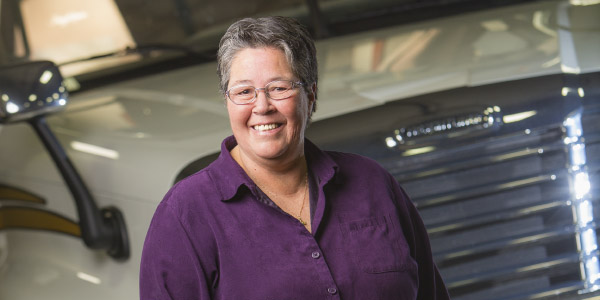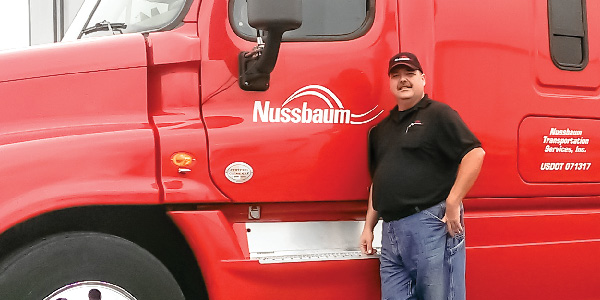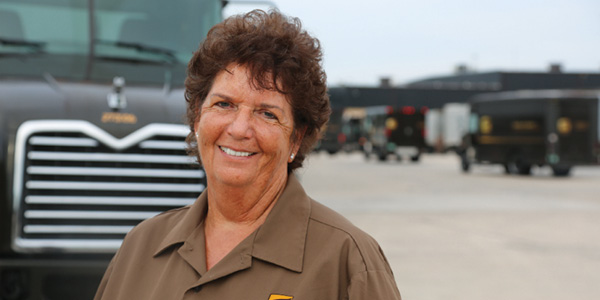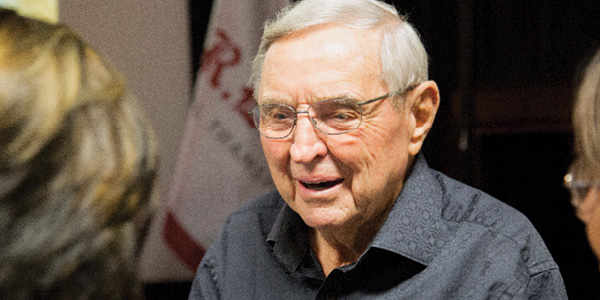Trucking From the Driver’s Seat

From first mile to last mile, and every mile in between, truck drivers are the lifeblood of your supply chain. Meet some of these dedicated professionals.
In the day-to-day business of managing your supply chain, it’s easy to forget that behind the routing software, network models, and demand forecasts are real people doing the demanding work of driving the trucks—a critical role in nearly every supply chain. Trucks are the backbone of the U.S. transportation system, and without the right people behind the wheel, all this hyper-charged supply chain activity would come to a screeching halt.
Luckily, the industry employs people such as Ron Fuller of Central Freight Lines, who is approaching five million miles of driving without a single accident. Sharp increases in traffic volume, and a motoring public uneducated on the physics of a fully loaded tractor-trailer moving at highway speeds, mean Fuller and his colleagues must stay extra vigilant to avoid danger. Fuller says he averages eight to 10 close calls every night. “Drivers have to constantly pay attention to what’s around them,” he says. “What I would describe as a normal day would probably scare the average person.”
Navigating crowded roadways is not the only challenge drivers face. They must know their equipment, and perform constant safety checks, in addition to complying with stringent regulations, meeting exacting schedules, waiting in long lines to load and unload, and coping with weather uncertainties.
Despite these challenges, many drivers embrace the opportunity to be out from behind a desk, interact with different types of people, and see the country. “Truck drivers are the original social media,” notes Norita Taylor, spokesperson for the Owner-Operator Independent Driver’s Association. “They were communicating with one another a long time ago, using CB radios. They help each other.”
The driving job takes many forms—from long-haul truckers who spend most days of the month away from home to drayage drivers working out of a local port. Drivers might work exclusively in areas such as hazmat, border crossings, reefers, flatbeds, fleet, or dedicated contract carriage, or every job may be different.
Ride along with Inbound Logistics as we celebrate a few veterans of the road.
Ron Fuller: 41 Years on the Road
Current job: Line less-than-truckload (LTL) driver for Central Freight Lines (CFL), a regional carrier based in Waco, Texas.
Driving experience: Bobtail, step van, tractor-trailer. Fuller drives one of CFL’s 114 compressed natural gas (CPG) trucks, part of a clean air initiative. Fuller was named the Texas Trucking Association Driver of the Year in 2012, and went on to be chosen as the National Driver of the Year by the American Trucking Associations.
How trucks have changed: Fuller has gone from gas to diesel and now CPG trucks, and saw the welcome addition of power steering, monitors and sensors, air conditioning, and other improvements. Early on, drivers had to check oil levels and spark plugs manually, and maintain repair skills. “If you had a breakdown during a long stretch of driving, and you couldn’t fix the truck, you had to hope the next driver who came along would stop and help,” he recalls. Paperwork was completed manually and carried on board, and losing it was a huge problem. Today, sensors monitor equipment conditions and recommend how to get the best fuel mileage, and communication is much improved. “Drivers have to be much more educated now because they have to understand the equipment they’re operating,” says Fuller. “These days, we use more brain than brawn.”
What he enjoys: Fuller has put himself on call as a mentor to new drivers. “The only way we can keep people in this industry is to be willing to nurture them,” he says.
Memorable moment: Fuller has saved a few lives while out on the road. In one instance, many years ago, the driver of a passenger vehicle stopped near him as he pulled off for a safety check. “I realized she was in distress,” Fuller recalls. Unwilling to leave the woman alone, he flagged down help to get her to a hospital.
What supply chain managers need to understand: Truck driving is a profession that deserves respect. “Drivers need to be dedicated to the profession; we’re the lifeblood,” Fuller says. “People hear you’re a truck driver and expect you to have a certain appearance, but drivers could wear a three-piece suit because they do not touch the delivery.” Fuller says he saw a change in how people regarded him only after he won the National Driver of the Year title.
Carrie Hall: 25 Years on the Road
Current job: K&J Trucking, a specialized refrigerated carrier in Sioux Falls, S.D.
Driving experience: Reefers, flatbeds, dedicated, tankers, double- and triple-trailers—”everything but cattle,” Hall says.
How she got started: Hall liked riding in the heavy equipment at her father’s construction business, so he suggested she try driving. She attended driving school, then rode along with an experienced driver for three weeks.
Best advice she has ever received: Her training driver taught her three things: never go downhill faster than you went up; be respectful of the name on the truck; and the job is not trial and error. An error can be devastating.
What has changed the most: “When I first started, I wanted to hang out at the truck stop or casino, then push to get to my destination,” says Hall. “That’s not fun. Now I take enough time, and it’s less stressful.” A hidden bonus is to arrive early because a receiving dock will often take delivery as much as one hour early, which can avoid a long wait when other trucks arrive.
Being a woman in trucking: There weren’t many female drivers when Hall started in 1989. “At first I wasn’t received well,” she recalls. “Other drivers would say, ‘let me back that truck into the dock for you,’ or ‘have your husband come in here.’ They could not comprehend that a female could do this job alone in a truck.” Today, most drivers are unfazed, she says.
Job highlights: Seeing the country and enjoying four seasons—her South Dakota neighbors experience only winter and summer. She also enjoys the variety. “Every day is different,” Hall says. “I was a paralegal for 18 months, and it drove me bonkers.”
What supply chain managers need to understand: The driver shortage has rushed people into the job, and training is sometimes compromised, Hall says. “It’s not safe for the general public,” she adds. “Drivers have to know how much weight they’re carrying, and the wind speed. They need to figure out that if they have 31,000 pounds of freight on the truck, with a 50 mile-per-hour wind, they need to drive at 61 mph,” Hall says.
Chip Brackett: 44 Years on the Road
Current job: Long haul hazmat for HazMat Environmental Group, a chemical products and by-products carrier based in Buffalo, N.Y.
Driving experience: Low boy, heavy haul, flatbed, and hazmat. Brackett enjoys working for HazMat Environmental because he feels the company puts safety before profits. He avoids jobs west of the Rockies because of strict enforcement practices in California, Nevada, and Oregon. “We always pass,” Brackett says, “but it takes a lot of time.”
How hazmat is different: Salaries—hazmat generally pays more—and status. “People respect drivers more when they display four, five, or six different hazard categories,” he says. “I see a difference in how I’m treated by Department of Transportation inspectors versus how they treat the average driver.”
How hazmat has changed: In 1973, Brackett picked up a load in Chicago and the shipper handed him a “respirator”—actually a paper face mask—and shared these instructions: “If you have an accident, run into the wind.” The shipper offered little regulation, or information. Beckett decided to take a six-month chemistry course to educate himself. Today, hazmat hauling requires initial and annual training. Hazmat regulations are changing to align with international requirements, so drivers need to keep up to date.
Material he avoids: Brackett hauls many different hazardous materials. He avoids temperature-controlled, full-strength organic peroxide. “It’s highly unstable at higher than 45 degrees,” he explains. “If the refrigeration quits, drivers only have a few hours to get it fixed or get dry ice before it creates a big hole in the ground. I’ve seen it.”
What supply chain managers need to understand: The implications of Hours-of-Service regulations. Like other drivers, Brackett says the 14-hour clock prevents him from stopping to take a break, contrary to the law’s intent to make driving safer.
Rob Miller: 22 Years on the Road
Current job: Dedicated contract carriage driver for Nussbaum Transportation in Hudson, Ill. Miller carries goods for a large consumer electronics company. He sleeps in his vehicle five nights a week, and makes it home on weekends.
Driving experience: Long haul, dedicated.
Why dedicated?: “Over-the-road drivers are at the mercy of everybody else,” says Miller. “But as a dedicated driver, I know where I will be at any given point each day, and can plan my life accordingly. I can stop at the same truck stops, know what time the lines form at the shower, and see the same people. It’s less stressful and easier to get quality sleep.” Dedicated jobs are coveted, and earned by those who demonstrate professionalism and accountability.
How driving has changed: Equipment is modernized, more comfortable, and more reliable. Miller recalls when he had to scrape ice off the truck’s inside windows to get going in winter, and the cab getting so hot one summer that soda cans exploded.
What he enjoys: Meeting new people and the opportunity to counsel new drivers.
What supply chain managers need to understand: “Dedicated transport scheduling is tighter because you only have so many hours to get the job done,” he says. “That time doesn’t factor in traffic jams or breakdowns. The roads are more crowded, but efficiency is tighter.”
Chuck Ceccacci: 17 Years on the Road
Current job: Intermodal driver, safety trainer, and investigator for Schneider, a truckload, logistics, and intermodal services provider based in Green Bay, Wis.
Driving experience: Dedicated long haul and intermodal. Switching to intermodal allowed Ceccacci to stay local in Atlanta, where intermodal drivers move goods to and from three major railheads.
What makes intermodal different: Intermodal trucks move non-stop, with containers being transported around yards, or live loaded, dropped, and retrieved from shippers. Containers are top-heavy and drivers must check locking pins constantly; skipping safety checks is not an option. “It’s a busy working environment, with many moving parts, particularly on the ramp,” Ceccacci says. “It’s not like on the road; the trains don’t blow horns. You have to keep your wits about you.”
What HAS changed the most: Safety. “Schneider gained thousands of chassis, so we can pre-trip our own equipment,” Ceccacci says. The alternative is a chassis pool, which tends to get more wear and tear, and drivers know less about how equipment has been maintained. “Safety has been greatly improved,” he says. “GPS and computer systems provide much more information and efficiency than we had 10 or 15 years ago.”
What he likes: Being outdoors, seeing sunrises and sunsets, and enjoying a sense of accomplishment. “Driving is still a relatively new industry, and it’s constantly changing,” Ceccacci says. “That makes it exciting. You never know what’s around the next curve.”
What supply chain managers need to understand: Intermodal operates on tight schedules, with a shipper or receiver on one end, and a rail schedule on the other.
Ginny Odom: 40 Years on the Road
Current job: Driving a 650-mile daily route for UPS towing twin 28-foot trailers from Orlando, Fla., to Unadilla, Ga., and back. Odom recently hit four million miles without an accident, the first female UPS driver to do so.
Driving experience: Delivery trucks and tractor-trailers.
How she got started: Odom grew up on a farm in Rutledge, Tenn., and mastered the clutch on a John Deere tractor when she was 12 years old. She applied to UPS while working in a boat store in Orlando. After nine years maintaining the hectic pace of delivery driving, Odom switched to tractor-trailers.
Best part of the job: “I love to drive and I love being outdoors,” Odom says. “I would go crazy in an office.” She also likes the camaraderie among fellow drivers, and their willingness to help one another. One example: recently, Odom noticed another UPS driver’s rear brake light malfunctioned, so she trailed him to help minimize the danger.
What has changed: Behavior on the roads, particularly since the emergence of cellphones. “Drivers are so involved with their phones and where they’re going that they don’t notice when a truck is in front of or behind them,” she says. Odom recalls a close call she had the day after hitting the four-million-mile mark, when a car cut her off. She also doesn’t like cars that cruise in the middle lane, because it’s the only option for a truck when passing.
What supply chain managers need to understand: “Every day is a challenge,” Odom says. “Truck drivers must drive for everyone else, and remain vigilant when others are not.”
Gene England: Still Trucking at 95
From produce truck driver to president emeritus of Salt Lake City-based C.R. England, one of North America’s largest transportation companies and temperature-controlled carriers, Gene England continues to thrive at age 95. He never fully retired. After turning over C.R. England’s leadership to his sons, Gene and his brother Bill founded G.B. Leasing, which provides vehicle lease options to employees, drivers, and independent contractors of C.R. England and itsaffiliates.
England’s father started up the C.R. England business by trucking the produce his neighbors grew. Gene enlisted in the U.S. Army during World War II, where he received the Bronze Star. He earned extra money by selling his cigarette rations, then used it to purchase a truck to help grow his father’s business. Following the war, Gene and Bill returned to work with their father, and expanded the company nationally. C.R. England became the first trucking company in the nation to offer 72-hour coast-to-coast delivery service, and Gene initially worked there as adriver.
That driving job has changed considerably since those early days, England says. “In 1946, it was a privilege to be able to drive a truck,” he notes. “A driver was recognized as a man who could handle a big unit, and there weren’t too manyaround.”
All the work was manual—steering and transmission—and the driver typically did all the loading and unloading. Today, he says, drivers don’t get the same respect. Some shippers won’t even allow drivers to use theirrestrooms.
The roads were much different,too.
“When C.R. England started service to the East Coast, there were two lanes from Los Angeles to Chicago, then we’d take the Turnpike east,” England recalls. That improved with the development of the Interstate Highway System in the 1950s, and truck stops began to proliferate. “Highways are vastly improved today,” he adds. “The volume of cars and trucks on the highways, however, makes it harder for drivers all thetime.”
Despite the challenges, driving is a job many people love to do, England says. “They enjoy traveling and seeing the beauty of the country.”







